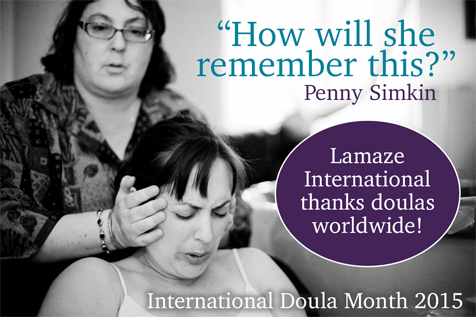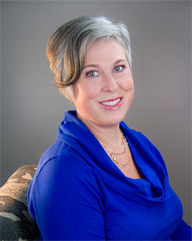May 06, 2015
Book Review: Birth Ambassadors; Doulas and the Re-Emergence of Woman-Supported Birth in America
By: Sharon Muza, BS, LCCE, FACCE, CD/BDT(DONA), CLE | 0 Comments
May is International Doula Month and Lamaze International recognizes the importance of labor support. (Note - there are both birth and postpartum doulas who work with families during the childbearing year. We are grateful for the work that they both do.) In fact, our third Healthy Birth Practice specifically addresses doulas and support people as an effective component of safe and healthy birth. The American College of Obstetricians and Gynecologists (ACOG) in their 2014 Safe Prevention of the Primary Cesarean Obstetric Care Consensus Statement stated "published data indicate that one of the most effective tools to improve labor and delivery outcomes is the continuous presence of support personnel, such as a doula." Childbirth educators and health care providers have ample opportunity to inform parents about the benefits of a doula when they are meeting with families and patients.
In mid-2014, sociologist Christine Morton, Ph.D. with Elayne G. Clift, MA, wrote a book, Birth Ambassadors: Doulas and the Re-Emergence of Woman-Supported Birth in America examining doulas from both an historical perspective as well as an assessment of the role of the doula in current American society . Kim James, LCCE and certified DONA birth doula, reviews this book and shares her perspective and take-aways with readers of this blog.
This book would make a great read for a book club book for birth professionals, and Kim generously shares some discussion questions at the end of today's post to facilitate your discussion, should you wish to participate. Alternately, if you have read the book, please feel free to respond in our comments section.
Science & Sensibility and Lamaze International want to thank all the doulas who work tirelessly to support families as they birth their babies and transition to parenthood. Happy International Doula Month. - Sharon Muza, Science & Sensibility Community Manager.
 Birth Ambassadors: Doulas and the Re-Emergence of Woman-Supported Birth in America, written by Christine Morton, Ph.D. with Elayne G. Clift, MA, is a thorough and compelling documentary of the history of doula support, the current dilemmas and issues facing the doula occupation, w
Birth Ambassadors: Doulas and the Re-Emergence of Woman-Supported Birth in America, written by Christine Morton, Ph.D. with Elayne G. Clift, MA, is a thorough and compelling documentary of the history of doula support, the current dilemmas and issues facing the doula occupation, w
By Kim James, BA, BDT(DONA), CD(PALS), ICCE, LCCE
hat drives doulas to pursue this work and how the work of doula support might fit into the future as the United States strains to find better ways of providing quality improvements in maternity care. For doula trainers and doulas looking to pursue this work in a professional manner, Birth Ambassadors is critical, mandatory reading. (For trainers and doulas interested in how to use this book to critically assess your work, please see the discussion questions below this article).
But what about for childbirth educators? What in it for them?
While the history is fascinating, it's the critical sociological analysis of the current dilemmas and issues facing the doula occupation that childbirth educators' need to thoroughly understand, especially Lamaze certified childbirth educators.Lamaze International's third Healthy Care Practice, 'Bring a Loved One, Friend or Doula for Continuous Support', outlines why continuous support is important and how a doula performs their work:
- Continuous support can help alleviate fear and worry.
- A doula's intuitive sense and training mean emotional and physical needs are met with timely, individualized care.
- Greater emotional and physical comfort may encourage the most efficient and healthy labor progress.
While most childbirth educators are aware of the intended benefits of doula care, not all are aware of the dilemmas doulas face in performing their work and the institutional and cultural issues that prevent doulas from having the greatest beneficial impact. Lamaze certified childbirth educators must have a firm understanding of these dilemmas so as not to "over-promise" what the third Lamaze Healthy Care Practice is intended to deliver.I want to highlight three dilemmas facing doulas that childbirth educators should be aware of and what they can do to educate parents who want doula-supported birth experiences:
 First dilemma
First dilemma
The ecological fallacy of applying aggregate results of research that show doula efficacy to an individual family's outcome. The cultural and institutional context of most US hospital births limit the doula's efficacy, often by prohibiting truly continuous support and refusing to recognize a doula's unique scope of practice. Childbirth educators should lead discussions with parents about what hospitals and which care providers in their areas are most and least supportive of doula care. Childbirth educators are instrumental in helping parents understand the questions they can ask during hospital tours and prenatal visits to find out if their chosen place of birth and attendant understand and support doulas attending families at births.
Second dilemma
The frequent contradiction between a doula's personal values (often a deep belief in the optimality of the midwifery model of care, natural, drug-free childbirth or specific parenting practices) and her obligation to provide unconditional support for parents' birth and parenting choices. Childbirth educators must help parents clarify their values around birth and parenting so that parents can find the support people who suit them best. Not every doula will be the best support for every parent.
Third dilemma
No occupation-wide standard for training or certification. The competing tensions within doula organizations between increased professionalization and maintaining low barriers to entry for all people to become doulas remain unresolved. While the majority of doulas are well-trained through recognized, long-standing organizations, some will only have received light, if any, training possibly through correspondence and online courses. Not every doula's skill set is the same. Not every doula will practice within a scope of practice that is evidence based. Not every doula will pledge to follow a recognized code of ethics backed by an organization with an active grievance policy. Childbirth educators who make referrals to families asking for doulas should always make referrals to doulas who are well-trained, consistently receive excellent feedback from the families they serve and most importantly practice in a manner that is consistent with the evidence based third Lamaze Healthy Care Practice.
As a current Lamaze certified childbirth educator and professionally-working certified doula, I found my own experiences reflected in this book. While at times uncomfortable to confront the dilemmas and issues our occupation faces, Birth Ambassadors is well worth reading for the history and reflections for the future. It will give childbirth educators who are not currently practicing doulas good data on what the real impact of doula support means for the families that hire them.
Book club discussion questions
When Birth Ambassadors was newly released, I hosted a book club-style discussion group with several local doulas to discuss this book's implications for our current and future work. Here are the big questions that came up for our group representing doulas who were well-established in their practices, those who were just starting out and both certified and non-certified doulas.
- When is your personal bias stronger than your ability to offer unconditional support? (Reference: page 195).
- Analyze this: "Doulas advocate evidence-based care for physiologic birth, yet are not trained clinically to recognize or treat women when their pregnancies and labors become non-normal". (Reference: page 37).
- The original purpose of the first doula organizations was to provide moral support for each other. What do we need from our organizations now? (Reference: page 90)
- Do we have the training to be professionally non-judgmental? (Reference: page 196).
- Doula neutrality - When do you abandon it? How do you maintain it? (Reference: page 261).
- What are the current debates around our standard of practice and code of ethics? (Reference: page 81).
- Outcome-based care vs emotional companionship: What are you drawn to in this work? (Reference: page 260)
- Are you comfortable with the "outsider-within" role? Does attract or repel you? (Reference: page 36)
How do you talk about doulas in your childbirth classes? In your midwifery or obstetrical practice? Have you read Birth Ambassadors? What were your big take-aways? Have you shared Lamaze International's "Who Says Three's a Crowd?" infographic with the families you work with?Note: Christine Morton is a member of Lamaze International's Board of Directors.
About Kim James
 Kim James BA, BDT(DONA), CD(PALS), ICCE, LCCE, is an ICEA and Lamaze certified childbirth educator teaching at Parent Trust for Washington Children/Great Starts where she sits on the Education Committee. She owns and operates www.DoulaMatch.net and is a DONA International and PALS Doulas certified birth doula as well as a DONA-approved birth doula trainer working at the Simkin Center/Bastyr University. Kim also volunteers her time on the Lamaze International membership committee and serves as Washington State DONA SPAR. Her daughters are 9 and 16 years old. Kim and her family live in Seattle, Washington.
Kim James BA, BDT(DONA), CD(PALS), ICCE, LCCE, is an ICEA and Lamaze certified childbirth educator teaching at Parent Trust for Washington Children/Great Starts where she sits on the Education Committee. She owns and operates www.DoulaMatch.net and is a DONA International and PALS Doulas certified birth doula as well as a DONA-approved birth doula trainer working at the Simkin Center/Bastyr University. Kim also volunteers her time on the Lamaze International membership committee and serves as Washington State DONA SPAR. Her daughters are 9 and 16 years old. Kim and her family live in Seattle, Washington.
Tags
Lamaze Educators International Doula Month Book Review Professional Resources Labor/Birth Maternal Infant Care Christine Morton PhD Kim James New Media childbirth education business Natural Birth personal business Birth Ambassadors Elayne G. Clift